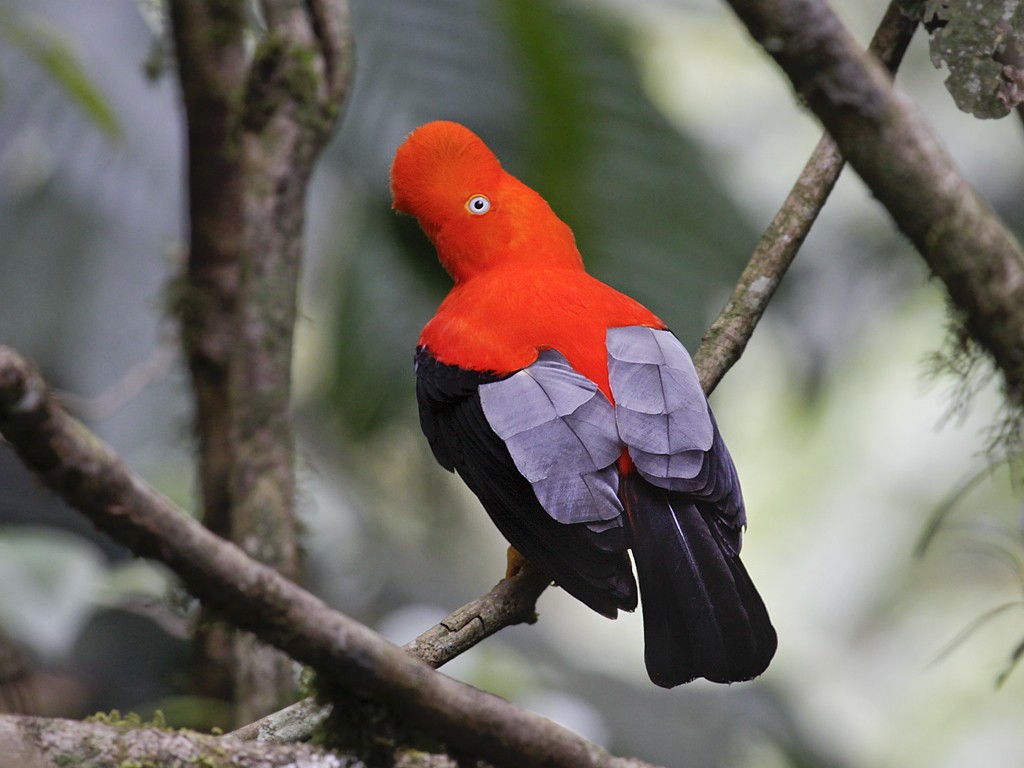Andean Cock-of-the-rock
A species of Cocks-of-the-rock Scientific name : Rupicola peruvianus Genus : Cocks-of-the-rock
Andean Cock-of-the-rock, A species of Cocks-of-the-rock
Botanical name: Rupicola peruvianus
Genus: Cocks-of-the-rock
Content
Description People often ask General Info
 Photo By Bill Bouton , used under CC-BY-SA-2.0 /Cropped and compressed from original
Photo By Bill Bouton , used under CC-BY-SA-2.0 /Cropped and compressed from original Description
The Andean cock-of-the-rock is a large passerine, approximately 32 cm (13 in) long and weighing around 265 grams (9.3 oz; 0.584 lb), although males are somewhat larger and the heaviest specimens can reach 300 grams (11 oz; 0.66 lb). The bird is one of many bird species to exhibit marked sexual dimorphism. The male has a large disk-like crest and brilliant scarlet or orange plumage. It has black tail and wings, and pale greyish scapulars. The female is significantly drabber and browner than the male and has a less prominent crest. The bill is yellowish in the male, and dark with a small yellow tip in the female. Depending on gender and subspecies there are significant variations in the color of the iris, ranging from red over orange and yellow to bluish-white in the male, and whitish over reddish to brown in the female. In addition to the display calls described in the breeding section below, foraging birds give a loud querulous “tank?” when disturbed or in flight. 
Size
32 cm
Colors
Black
Red
Gray
Orange
Life Expectancy
7 years
Nest Placement
Cliff
Feeding Habits
Andean Cock-of-the-rock mainly eats fruits and insects, including those from Lauraceae, Annonaceae, and Rubiaceae families. They occasionally consume small reptiles and frogs, prefer fruit over high-protein varieties, and follow army ants for food.
Habitat
Andean Cock-of-the-rock typically inhabits lush montane forests, favoring regions that are often dense with foliage and are traversed by streams or located in ravines. Preferring altitudes ranging from 500 to 2400 meters above sea level, these birds are usually encountered in the lower to middle strata of the forest, though they are known to ascend to higher levels when foraging in fruit-bearing trees. Andean Cock-of-the-rock may occasionally venture into clearings, but their primary preference is for environments that offer both abundant cover and food resources.
Dite type
Frugivorous
People often ask
General Info
Feeding Habits
Bird food type

Fruit
Distribution Area
The Andean cock-of-the-rock is distributed in cloud forests of the Andes. It lives in a large range of about 260,000 km (100,000 sq mi) across Venezuela, Colombia, Ecuador, Perú, and Bolivia, mostly in ravines and forested streams in montane areas at 500 to 2,400 m (1,600 to 7,900 ft) elevation. It typically stays in the lower and middle forest levels, but will range higher in fruiting trees and will sometimes enter and cross clearings. It is generally shy and inconspicuous, often seen only briefly after being flushed out or while swiftly flying down a valley. R. p. aequatorialis is the most widespread subspecies, ranging across the Andes of East Colombia to West Venezuela, East Ecuador and East Peru. The nominate subspecies, R. p. peruvianus has a small range stretching only through the Andes of Central Peru. R. p. sanguinolentus ranges throughout the Andes in West Colombia to Northwest Ecuador. The subspecies R. p. saturatus has a range across Southeast Peru and West Bolivia. 
Species Status
The worldwide population size and trends in population numbers have not been determined, but it is believed that the Andean cock-of-the-rock is not threatened. The species is evaluated as Least Concern on the IUCN Red List of Threatened Species despite habitat destruction. It is patchily distributed, but its range is large enough to sustain it at a Least Concern status. 
Scientific Classification
Phylum
Chordates Class
Birds Order
Perching birds Family
Cotingas Genus
Cocks-of-the-rock Species
Andean Cock-of-the-rock